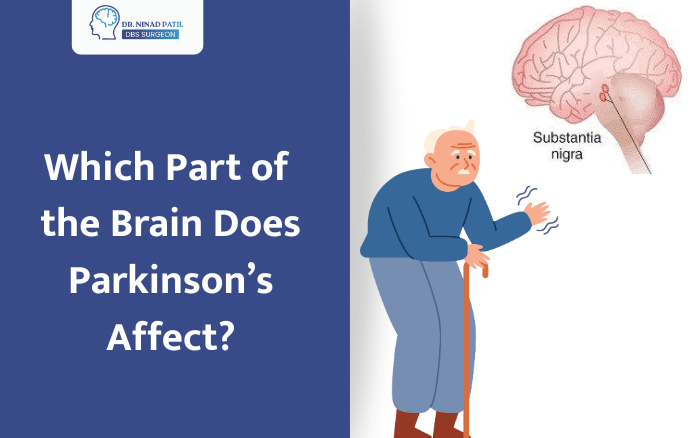If you’ve noticed a tremor in your hand or found it harder to move as smoothly as you used to, you might be wondering what’s happening inside your brain. Parkinson’s disease is a condition that affects specific parts of the brain, and understanding which areas are involved can help you make sense of the symptoms you’re experiencing.
Let’s explore exactly what part of your brain Parkinson’s disease affects and why it causes the symptoms it does.
The Main Target: Substantia Nigra
The primary area affected by Parkinson’s disease is a small region called the substantia nigra. This tiny part of your brain, located in the midbrain, plays a huge role in how you move.
Think of the substantia nigra as your brain’s dopamine factory. Dopamine is a chemical messenger that helps control movement, coordination, and balance. In a healthy brain, the substantia nigra produces plenty of dopamine to keep everything running smoothly.
When Parkinson’s disease develops, the cells in the substantia nigra begin to die off. By the time symptoms appear, about 60-80% of these dopamine-producing cells are already gone. This dramatic loss of dopamine is what triggers the movement problems associated with Parkinson’s.
▶ Read More About Parkinson’s disease
Why Dopamine Loss Matters
You might wonder why losing dopamine causes such noticeable problems. Here’s a simple way to understand it:
Dopamine acts like a messenger between different parts of your brain that control movement. When there’s enough dopamine, these messages flow smoothly, and your movements are fluid and coordinated. When dopamine levels drop, the messages get disrupted, making movements slow, stiff, and shaky.
This explains the classic Parkinson’s symptoms: tremors (shaking), rigidity (stiffness), and bradykinesia (slow movement). Your brain wants to move, but without enough dopamine, the signals don’t get through properly.
The Basal Ganglia: Movement Control Center
The substantia nigra doesn’t work alone. It’s part of a larger network called the basal ganglia, which includes several connected structures deep in your brain.
The basal ganglia helps you:
- Start and stop movements
- Control the speed and smoothness of motion
- Perform automatic movements like swinging your arms when you walk
- Maintain posture and balance
When Parkinson’s damages the substantia nigra, it disrupts the entire basal ganglia network. This is why people with Parkinson’s often have trouble starting movements, experience “freezing” episodes, and develop a shuffling walk.
Beyond Movement: Other Affected Areas
While the substantia nigra and basal ganglia are the main targets, Parkinson’s can eventually affect other brain regions as the disease progresses.
▸ The Brainstem
Parts of the brainstem get involved early in Parkinson’s. This affects functions like:
- Sleep patterns (leading to insomnia or vivid dreams)
- Blood pressure regulation (causing dizziness when standing)
- Digestion (resulting in constipation)
▸ The Sense of Smell
Interestingly, the area controlling smell—the olfactory bulb—is often affected years before movement symptoms appear. Many people with Parkinson’s lose their sense of smell long before their diagnosis. If you’ve noticed you can’t smell foods or flowers like you used to, it might be an early warning sign.
▸ The Emotional Centers
Regions that regulate mood and emotions can also be affected. The same dopamine deficiency that impacts movement also influences feelings of motivation, pleasure, and emotional well-being. This explains why depression and anxiety are common in Parkinson’s patients—it’s not just about coping with the diagnosis; it’s a direct result of brain changes.
▸The Thinking Brain
In later stages, Parkinson’s can spread to the outer layer of the brain—the cerebral cortex—which controls thinking, memory, and decision-making. Not everyone experiences this progression, but some people develop memory problems or difficulty with planning and problem-solving over time.
How Brain Changes Explain Your Symptoms
Understanding which parts of your brain are affected helps explain the specific symptoms you might experience:
- Tremor: Results from imbalanced signals in the motor control circuits. The classic “resting tremor” happens when muscles receive conflicting messages about whether to tense or relax.
- Stiffness: Occurs because the brain sends continuous tension signals to muscles without the normal “relax” messages that dopamine would provide.
- Slow Movement: Happens when there isn’t enough dopamine to activate the circuits that initiate and maintain movement.
- Balance Problems: Develop as Parkinson’s affects the parts of the basal ganglia responsible for automatic balance adjustments.
- Sleep Issues: Come from brainstem involvement affecting sleep-wake cycles.
- Constipation: Results from nervous system changes affecting the gut, which happens early in the disease
What This Means for Treatment
Knowing which parts of the brain are affected helps doctors choose the right treatments. Most Parkinson’s medications work by either:
- Replacing the missing dopamine
- Mimicking dopamine’s effects
- Preventing dopamine breakdown in the brain
These medications can significantly improve symptoms, especially in the early and middle stages. While they don’t stop the disease from progressing, they help restore some of the chemical balance your brain needs for better movement and function.
For some people, a treatment called deep brain stimulation can help. This involves placing small electrodes in specific parts of the basal ganglia to regulate the abnormal signals causing symptoms.
Struggling with Movement? Don’t Wait to Get Answers
Understanding what happens in your brain with Parkinson’s disease helps you feel more in control. While the disease does cause permanent changes to brain cells, treatments can effectively manage symptoms and help you continue doing the things you enjoy.
If you’re in Pune and experiencing symptoms like tremors, stiffness, or slow movement, Dr. Ninad Patil is a trusted Parkinson’s disease doctor who can help. Dr. Patil focuses on movement disorders and provides complete care for people with Parkinson’s, from accurate diagnosis to ongoing treatment and support.
Don’t wait to get help. Early treatment can make a significant difference in managing your symptoms and maintaining your independence.
Schedule a consultation with Dr. Ninad Patil to discuss your symptoms and explore treatment options that work for you.


